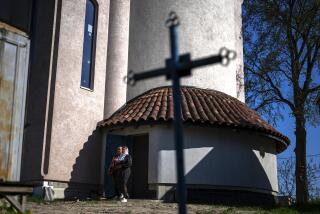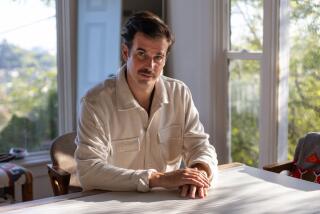Portraits of Faith, Hope and History
In an Orthodox church watched over by saints and martyrs, Russian-born painter Victor Kazanin perfects his creations.
Driven by a vision that not even he fully understands, the artist adds curls of shadow and hints of blush to a canopy of images now covering the walls and ceiling of a little-known sanctuary near Oxnard.
It is not so much a job for Kazanin as it is a testament of faith.
That spiritual core serves as his guide during marathon sessions of prepping and painting, each stroke bringing him closer to transforming the church into a reflection of its imperial Orthodox past.
“It is difficult to explain the energy or where it comes from, but I don’t seem to have direct control,” said Kazanin, who was lured from Washington by church leaders eager to tap a centuries-old Orthodox tradition of blending art and religion. “It feels to me like a gift. When I do a painting, I feel as if God is in me.”
The Russian immigrant and his larger-than-life frescoes appear out of place in this barrio next to Oxnard called El Rio, where most of the immigrants are Latino.
But Kazanin provides an important link to Ventura County’s immigrant past, opening a window on an era that saw the arrival of hundreds of World War II refugees who worked the area’s rich farmland in the late 1940s and early 1950s.
*
A small community of displaced people--mostly Russians, but Hungarians and Latvians too--banded together in 1966 to raise the Holy Trinity Eastern Orthodox Church in an avocado grove.
“It was a hard time for everybody and I would say it is a miracle we stayed alive,” said Victor Bublick, 79, of Camarillo, a church founder who has watched membership dwindle from hundreds of parishioners to about 30 on most Sundays. “That is why we built the church, to thank God for that, and now we are doing something in keeping with our tradition.”
The sanctuary is barely visible from the Ventura Freeway, its spires poking above rooftops like ice cream swirls atop sugar cones.
Ringed by wrought-iron bars, the church compound is like an island in this neighborhood where some roads are only dirt and the streets flood after a hard rain.
The outside of the church embodies the unmistakable character of Russian architecture, but the interior never matched the vision of its creators until Kazanin arrived in 1996.
On once empty walls, he has spread brilliant biblical scenes and solemn-faced icons in acrylic splashes of teal and crimson and gold.
Visitors are greeted by oversize versions of the Lord’s Prayer, in English on one side and Russian Cyrillic on the other. A wall scene depicts Palm Sunday, with Christ riding into Jerusalem on a donkey. On the ceiling there is a work titled “The Ascension of Our Lord,” depicting angels lifting an 8-foot-tall Christ figure to the heavens after the Resurrection.
And in neat lines, like postage stamps marching across the plaster, are portraits of saints and martyrs, their eyes emotionless in keeping with the Byzantine style that grew to become Russia’s national art form.
“We’re dealing with a level of artist that is extremely hard to find in this country,” said church member Valentin Gladstone. “We feel privileged to have him here.”
And when the work is done, Kazanin hopes there is another church that will hire him. He is a permanent resident, and hopes to become a U.S. citizen. He says he could earn far more as a commercial artist but that “money is not the important thing.”
“This is my life, my whole life,” Kazanin said. “I know it is a hard thing for people to understand, but I am working from my soul.”
More to Read
Sign up for Essential California
The most important California stories and recommendations in your inbox every morning.
You may occasionally receive promotional content from the Los Angeles Times.










